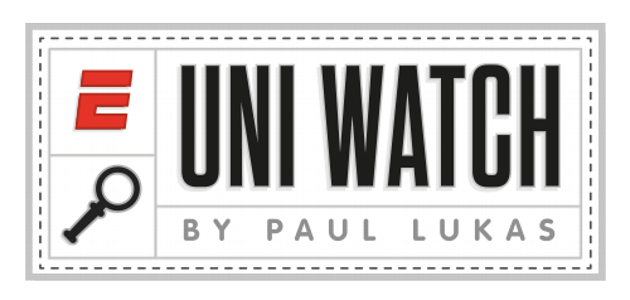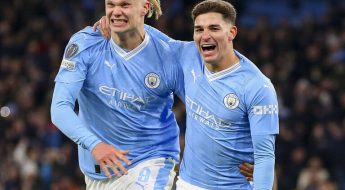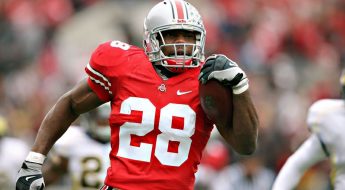Uni Watch: Has the black uniform trend finally peaked?


In 2003, the Detroit Lions made a series of changes to their uniforms. The changes all had one thing in common: They involved the color black.
The helmet logo was given a black outline. Black trim was added to the striping on the helmet, jersey sleeves, jersey collar and pants. The jersey numbers were outlined in black. Black “Lions” lettering was added to the jersey chest. Even the team’s face masks were affected, changing from blue to black. The team upped the ebony ante in 2005, adding a black alternate jersey that was accessorized with black socks.
Lions have said that their new uniforms, to be unveiled on April 13, will not have any black. So we’ve seen the last of this, thankfully. pic.twitter.com/BszNf6jubh
— Paul Lukas (@UniWatch) February 13, 2017
The Lions’ move toward the dark side has frequently been attributed to then-GM Matt Millen, who wore black during his playing days with the Oakland Raiders and was known to favor the black-centric look. But while Millen left the team in 2008, the black uniform elements have remained. Just last year, in fact, the Lions unveiled a black Color Rush uniform (although it wasn’t worn because the team didn’t have a Thursday night game on its schedule).
This has put the Lions squarely in the middle of the biggest uniform trend of the past generation, a trend that has rippled through all sports and all leagues: the sudden, often confounding embrace of black by teams that had never previously used it in their color schemes. Some teams did it to look more intimidating; some teams did it to sell more jerseys and caps; and some teams just did it because so many other teams were doing it. But regardless of the reasons, the effect was the same: a huge influx of black and black-accented uniforms. This phenomenon, which began in the late 1990s, has become known among uniform enthusiasts as BFBS — short for “black for black’s sake.”
But that’s about to change, at least for the Lions. The team will be unveiling a new uniform set on April 13 and has already announced one aspect of the revamped design: Black is being banished from the team’s visual program.
That will put the Lions on the leading edge of what appears to be another trend, albeit a newer and, so far, smaller one: The move away from BFBS by teams that had previously adopted it. That’s not to say BFBS is dead — it isn’t, not by a long shot — but the pendulum has begun to swing in the other direction.
“The shark definitely got jumped,” said Todd Radom, a sports branding expert who’s created uniforms and logos for a variety of pro teams. “And the Lions are a perfect example because black didn’t add anything meaningful for them.”
But Radom sees another factor at work aside from the inevitable cycle of trends running their course. “I think we’ve now gotten used to seeing things, including streaming sports content, in a digital space, especially on our phones,” he said. “When you’re dealing with that small digital space, vibrant colors now drive our perceptions, and black is not vibrant. Also, when you think about stadiums and arenas, we’re now in an LED world, and again, all of that is vibrant. I think that’s a huge factor driving this.”
Just to be clear, black is, and always has been, a perfectly fine uniform color — for some teams. If you’re the Pittsburgh Steelers, the San Antonio Spurs, the San Francisco Giants, or the Boston Bruins, for example, the color is part of your DNA. And black can even be a good alternate color for certain teams, like the Baltimore Ravens. (Real ravens, after all, are black.) But it was never a good fit for the Lions or for many of the other teams that hopped aboard the BFBS bandwagon over the past 20 years.
So what is the current state of BFBS? Let’s find out by taking a sport-by-sport look at the four major pro leagues. The rundowns that follow are not meant to be all-inclusive (going over every single team that used gratuitous black over the past 20 years would take all day), but they provide a good overview of how the use of black has waxed and waned in the various sports.
NFL
The Lions’ upcoming uniforms will be a major blow against BFBS, but there’s still plenty of work to be done on the gridiron. Teams to keep an eye on include the following:
• Cardinals: The Cards have worn a BFBS alternate uniform, complete with black-trimmed pants and black socks to go along with the black jersey, for the past seven seasons. It has never made sense and has never looked good on the field. Granted, this team’s uniform program has bigger problems than an alternate uni that’s worn only twice per season, but still, this design needs to go.
A team that needs to follow the Lions’ lead and ditch the black: the Cardinals. pic.twitter.com/BpKoqiRZ51
— Paul Lukas (@UniWatch) February 13, 2017
• Eagles: Technically speaking, black is an Eagles team color (the club’s standard uniforms include black socks and black trim), but come on — do they really need that black alternate jersey? They’ve worn it with three pant colors since introducing it in 2003, and it still doesn’t feel very Eagles-y. It’s time to get rid of it and go with a kelly green throwback instead.
Eagles have worn black jersey, introduced in 2003, with three different pant colors. pic.twitter.com/9fH3NkE1ub
— Paul Lukas (@UniWatch) February 9, 2017
• 49ers: The Niners are an interesting case. In the late 1990s they added lots of black trim to their helmet, jersey numbers and pants (sort of a junior version of what the Lions would do in 2003). The good news is that they got back to basics and scrapped all the black elements in 2009, so it looked like they were leaving BFBS behind. The bad news is that they added a completely ridiculous black alternate uniform in 2015. Memo to 49ers HQ: You know that uniform doesn’t work. Everyone knows it doesn’t work. Please scrap it and leave black for the NFL’s other Bay Area team.
Hmmmm, which Bay Area NFL team should wear black? (Hint: Not these guys.) pic.twitter.com/82BXpdWiHN
— Paul Lukas (@UniWatch) February 13, 2017
MLB
The baseball diamond is arguably where BFBS first took root, but many teams have since either moved away from it or at least dialed it back. For example:
• A’s: For more than half a century now, the A’s have been all about green, gold and white. But they’ve dabbled with two black jerseys — one in 2000 and the other from 2008 through 2010. But they’ve been happily BFBS-free since then.
The A’s have had two different black jerseys. Thankfully, both of them are now mothballed. pic.twitter.com/804p6OeUOa
— Paul Lukas (@UniWatch) February 13, 2017
• Blue Jays: It seems pretty obvious that a team called the Blue Jays should wear, you know, blue. But from 2004 through 2011, the Jays inexplicably went heavy on the black. Fans and ornithologists alike cheered when the team went back to wearing blue in 2012.
Remember when the Blue Jays were the black Jays? pic.twitter.com/L9I7cY1fG9
— Paul Lukas (@UniWatch) February 10, 2017
• Mets: The Mets were among the teams that went all-in for the dark side. At various points from 1998 through 2011, they had two black alternate caps, two black alternate jerseys (which at one time were listed in the official MLB style guide as “club preferred,” even though they were supposedly alternates), black drop-shadows on all of their jersey lettering and numbering, black undershirts and even a black alternate logo. But they left most of that behind in 2012 and eliminated the last vestiges of BFBS in 2013. This is a case study of a team embracing gratuitous black and then moving away from it. (The full backstory on how the Mets started using black in the first place can be found here.)
The Mets wore a lot of black in the late ’90s and early 2000s. pic.twitter.com/jBfhkLDu8n
— Paul Lukas (@UniWatch) February 13, 2017
• Rangers: The Rangers have never had a black jersey, but they did experiment with a short-lived black-brimmed cap.
Rangers never had a black jersey (thankfully), but they did have black-brimmed caps for a short period. (h/t @bradholmes23) pic.twitter.com/n9SpD41ID9
— Paul Lukas (@UniWatch) February 13, 2017
• Reds: The Reds went a little black-happy in 1999, adding black caps, black undersleeves, black socks and a variety of black accents and drop-shadows. The drop-shadows are still there, but they’ve dialed back the other black elements.
The Reds were another MLB team that wore a lot of black. pic.twitter.com/blV29EjiRL
— Paul Lukas (@UniWatch) February 13, 2017
• Royals: The Royals’ BFBS era was short but packed. From 2002 through 2006, they wore a black alternate cap, two black alternate jerseys, black drop-shadows on their jersey lettering and numbering, road vest jerseys that were paired with black undershirts and even a black-crowned sleeve patch (which, when you think about it, makes no sense at all). But by 2007, they were back to their classic look.
Royals had lots of black caps, jerseys, drop-shadows, and base-layer shirts from 2002-2006. All gone now, thankfully. pic.twitter.com/9HzHUTVdMr
— Paul Lukas (@UniWatch) February 13, 2017
NHL
Lots of NHL teams have dabbled with gratuitous black uniform elements, but most of them have either scaled it back or abandoned it altogether, so hockey’s BFBS trend line is clearly on the downswing. Here’s a selective rundown:
• Blackhawks: Black has always been part of the Blackhawks’ color scheme (they are the Blackhawks, after all), and it’s worth noting that the uniforms from the team’s earliest years were very black-centric. Still, the black alternate uniform that the team introduced in 1996 felt like a classic BFBS move. And sure enough, they mothballed that design in 2009, when the BFBS trend began to ebb.
Black has always been a Blackhawks team color. But this uniform still seemed like a bit much. pic.twitter.com/kLBblOvDU8
— Paul Lukas (@UniWatch) February 13, 2017
• Capitals: Remember how the Caps wore a black uniform from 1997 through 2007? No? Well, you’re probably not the only one who’s tried to forget that design.
Tales from the dark side: When the Capitals wore black uniforms. pic.twitter.com/mL8TGxlyqs
— Paul Lukas (@UniWatch) February 13, 2017
• Flames: The Flames were part of the first wave of BFBS. In 1998 they added a black alternate uniform, which was upgraded to primary status and become the team’s road design. Although that uni was scrapped in 2006, black has maintained a prominent place in Calgary’s visual program, most notably on the chest of the team’s home jersey.
This Flames black alternate uniform, introduced in 1998, later became the team’s primary road uni. pic.twitter.com/vWI3FZzxsv
— Paul Lukas (@UniWatch) February 13, 2017
• Flyers: Black has always been part of the Flyers. Still, it seemed like a bit much when the team unveiled a black alternate uniform in 1997. That design was soon redesignated as Philly’s road uni, and then it became the home design in 2003. But like so many other teams that experimented with black, the Flyers eventually decided to get back to their roots, jettisoning the black design in 2010.
Black is a Flyers team color, but they went a bit overboard with these designs. pic.twitter.com/Fay3XtRyag
— Paul Lukas (@UniWatch) February 13, 2017
• Islanders: The poor Isles can’t do anything right. They waited until 2011 to go BFBS, by which time most other teams had scrapped the black. Even worse, their BFBS design was laughably bad.
Worst black uniform ever? Or just the worst uniform ever, period? pic.twitter.com/RIv8GfRZkp
— Paul Lukas (@UniWatch) February 13, 2017
When the Isles moved to Brooklyn in 2015, they came up with a new BFBS uniform to match the black-and-white color palette of their fellow arena tenants, the Brooklyn Nets. Nice idea, but now it appears that the Isles might soon be leaving Brooklyn, so the whole point of the black uniform will be rendered moot. Just stick to blue and orange, guys!
Isles’ black uni is meant to match their fellow arena tenants, the Nets. But that’ll be moot if reports of Isles leaving Brooklyn are true. pic.twitter.com/DPgAbMvLWa
— Paul Lukas (@UniWatch) February 13, 2017
• Sabres: Buffalo’s core colors have been blue and gold for most of the franchise’s history, but they had a black-centric color scheme from 1996 through 2006. They’ve had other uniform problems since then (remember the Buffaslug logo?), but BFBS hasn’t been among them.
People tend to forget that the Sabres once wore black-centric uniforms. (The Buffaslug became a much bigger area of concern!) pic.twitter.com/1sA3PWqjvj
— Paul Lukas (@UniWatch) February 13, 2017
NBA
The hardwood appears to be where BFBS is making its last stand. While a few NBA teams have moved away from the dark side (the Knicks, for example, added lots of black trim in 1997 but scrubbed those elements from their uniforms in 2012), a larger number of teams have added black uniforms to their wardrobes in recent years, including the Bucks, Cavaliers, Clippers, Hornets, Lakers, Rockets and Warriors. Then there are teams like the Celtics, who have had a black-trimmed alternate uni for more than a decade now.
But NBA uniforms will soon be undergoing big changes. Nike is taking over from Adidas next season as the league’s uniform outfitter; advertising patches are being added to team jerseys; sleeves might be on the way out; and wholesale changes could be in store for many teams.
Will those changes include a move away from BFBS? We’ll find out soon enough. But in the other major pro leagues, it’s clear the black plague is on the wane. Here’s hoping the pendulum keeps swinging in that direction.
Paul Lukas, a lifelong Mets and 49ers fan, has felt the pain of BFBS on a very personal level. If you like this column, you’ll probably like his Uni Watch Blog, plus you can follow him on Twitter and Facebook. Want to learn about his Uni Watch Membership Program, be added to his mailing list so you’ll always know when a new column has been posted or just ask him a question? Contact him here.






